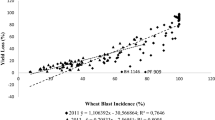Abstract
In the present study the degree of partial resistance (PR) of eleven hexaploid wheat (Triticum aestivum L.) genotypes was evaluated in laboratory (ratio of infection units in stage of second germ tube elongation versus stage of appressorium formation — ESH/App) and field conditions (calculating area under the disease progress curve — AUDPC). Based on the obtained data, genotypes with high degree of PR (Estica, GK Csornoc and Lívia), middle-resistant genotypes (Sana, Mv Vilma and Folio), genotypes with low portion of PR (Barbara, Torysa and Proteinka), and supersensitive genotypes (Renesansa and Am22/99) were differentiated. Both approaches appeared to be suitable for PR measuring with a good discriminating capability between the given genotypes. The results were equivalent in both instances. In addition, a new statistical approach permitting comparison of the obtained data is described.
Similar content being viewed by others
References
Andersen J.B. & Torp J. 1986. Quantitative analysis of the early powdery mildew infection stages on resistant barley genotypes. J. Phytopathol. 115: 173–186.
Babajanc L. 1988. Metody sekcii i ocenki ustojchivosti pshenicy i jachmenya k boleznjam v stranach — Chlenach SEV. Praha, 321pp.
Brown J.K.M. 2002. Yield penalties of disease resistance in crops. Curr. Opin. Plant Biol. 5: 339–344.
Caldwell R.M. 1968. Breeding for general and/or specific plant disease resistance, pp. 263–272. In: Finlay K.W. & Shepherd K.W. (eds), Int. Wheat Genet. Symp., 3rd ed., Sydney.
Carver T.L.W. 1986. Histology of infection by E. graminis f. sp. hordei in spring barley lines with various levels of partial resistance. Plant Pathol. 35: 232–240.
Carver T.L.W. & Carr J.H. 1978. Effects of host resistance on the development of haustoria and colonies of oat mildew. Ann. Appl. Biol. 88: 171–178.
Carver T.L.W., Robbins, M.P. & Zeyen, R.J. 1991. Effects of two PAL inhibitors on the susceptibility and localized autofluorescent host cell responses of oat leaves attacked by Erysiphe graminis DC. Physiol. Mol. Plant Pathol. 39: 269–287.
Carver T.L.W., Roberts P.C., Thomas B.J. & Lyngkjćr M.F. 2001. Inhibition of Blumeria graminis germination and germling development within colonies of oat mildew. Physiol. Mol. Plant Pathol. 58: 209–228.
Hautea R.A., Coffman W.R., Sorrels M.E. & Bergstrom G.C. 1987. Inheritance of partial resistance to powdery mildew in spring wheat. Theor. Appl. Genet. 73: 609–615.
Hwang B.K. & Heitefuss R. 1982. Characterization of adult plant resistance of spring barley to powdery mildew (Erysiphe graminis f. sp. hordei). II. Infection process at different leaf stages. Phytopathol. Z. 104: 179–190.
Hyde P.M. 1976. Comparative studies of the infection of flag leaves and seedling leaves of wheat by Erysiphe graminis. Phytopathol. Z. 85: 289–297.
Jones L.T. & E.R. Davies 1985. Partial resistance to Erysiphe graminis hordei in old European barley varieties. Euphytica 34: 499–507.
Jones I.T. & Hayes J.D. 1971. The effect of sowing date on adult plant resistance to Erysiphe graminis f. sp. avenae in oats. Ann. Appl. Biol. 68: 31–39.
Liu S., Griffey C. A. & Saghai Maroof M. A. 2001. Identification of molecular markers associated with adult plant resistance to powdery mildew in common wheat cultivar Massey. Crop Sci. 41: 1268–1275.
Lutz J., Limpert E., Bartoš P. & Zeller F.J. 1992. Identification of powdery mildew resistance genes in common wheat (T. aestivum L.) I. Czechoslovakian genotypes. Plant Breeding 108: 33–39.
McDonald B.A. & Linde C. 2002. Pathogen population genetics, evolutionary potential and durable resistance. Ann. Rev. Phytopathol. 40: 349–379.
McIntosh R.A., Devos K.M., Dubcovsky J., Roggers W.J., Morris C.F., Appels R. & Anderson O.D. 2006. Catalogue of gene symbols for wheat: 2006 Supplement. The Grain Genes homepage http://wheat.pw.usda.gov/ggpages/wgc/2006upd.html (accessed 14.5.2007).
Miedaner T. & Sperling U. 1995. Effects of leaf rust on yield components of winter rye hybrids and assessment of quantitative resistance. J. Phytopathol. 143: 725–730.
Niks R.E. & Rubiales D. 2002. Potentially durable resistance mechanisms in plants to specialized fungal pathogens. Euphytica 124: 201–216.
Parlevliet J.E. 1978. Further evidence of polygenic inheritance of partial resistance in barley to leaf rust, Puccinia hordei. Euphytica 27: 369–379.
Perugini L., Murphy J., Marshall D. & Brown-Guedira G. 2008. Pm37, a new broadly effective powdery mildew resistance gene from Triticum timopheevii. Theor. Appl. Genet. 116(3): 417–425.
Russel G.E., Andrews C.R. & Bishop C.D. 1976. Development of powdery mildew on leaves of several barley varieties at different growth stages. Ann. Appl. Biol. 82: 468–467.
Singh R.P. & Rajaram S. 2002. Breeding for disease resistance in wheat, pp. 141–156. In: Curtis B.C., Rajaram S. & Gómez Macpherson H. (eds), Bread Wheat: Improvement and Production. Plant Production and Protection Series no. 30. FAO, Rome.
Shaner G. 1973. Reduced infectability and inoculum production as factors of slow mildewing in Knox wheat. Phytopathol. 63: 1307–1311.
Shaner G. & Finney R.E. 1977. The effect of nitrogen fertilization on the expression of slow-mildewing resistance in Knox wheat. Phytopathol. 67: 1051–1056.
Vale R.F.X., Parlevliet J.E. & Zambolim, L. 2001. Concepts in plant disease resistance. Fitopatol. Bras. 26: 577–589.
Young N.D. 1996. QTL mapping and quantitative disease resistance in plants. Annu. Rev. Phytopathol. 34: 479–501.
Yu D.Z., Yang X.J., Yang L.J., Jeger, M.J. & Brown J.K.M. 2001. Assessment of partial resistance to powdery mildew in Chinese wheat varieties. Plant Breeding 120: 279–284.
Author information
Authors and Affiliations
Corresponding author
Rights and permissions
About this article
Cite this article
Mikulová, K., Bojnanská, K. & Červená, V. Assessment of partial resistance to powdery mildew in hexaploid wheat genotypes. Biologia 63, 477–481 (2008). https://doi.org/10.2478/s11756-008-0078-z
Received:
Accepted:
Published:
Issue Date:
DOI: https://doi.org/10.2478/s11756-008-0078-z




